
Switzerland - Swiss Federal Railways SBB-FFS-CFF electric locomotives and EMUs
For a full scale picture, please click on the picture shown !

In the mid- and late 1800s Switzerland was already full of different railroads, almost none of which cooperated in any way.
The technical systems as well as ticketing and timetables were a full mess. Industrialisation of the country pressed
on and the need for efficient railroad connections and goods transport became more and more obvious. There was by no means a lack of
railroads: at the end of the 1800s this small country had already 3091 km of normal gauge, 507 km narrow gauge and over 270 km
tram railroad. Finally, in a popular vote - as the Swiss tradition goes - on the 20th February 1898 the Swiss people decided it was
time to socialise the most important railroad companies and "buy them back to the state". The idea of the Swiss state railways
had been born. SBB saw finally daylight as an organisation in 1902 after several complicated political discussions. Important
railroad companies such as the Vereinigten Schweizerbahnen VSB and the Jura-Simplon-Bahn JS were rapidly bought. After extremely difficult
political play also the strategic Gotthard mountain route through the Alps was forcefully taken over from its owners and added to the
SBB network in 1909. SBB got its first at the time modern locomotives in 1907 when the strong and fast A 3/5 steam engines started
pulling first state express trains.
It hasn´t been all smooth sailing and the socialisation was never properly completed, but nevertheless, today´s SBB is clearly one of
Europe´s leading train companies with a large network, modern and impressive trains and surprisingly numerous users - operating on difficult
mountain lines with punctuality taken almost to perfection - something that most other state railroads can only dream about.
This is the today's newest and finest Swiss train, SBB's RABe 501, built by the famous Swiss company Stadler and nicknamed Giruno. It's
the world's first singledecker low-floor high speed train. It functions with three electric systems: 15 kV 16,7 Hz AC, 25 kV 50 Hz AC and 3 kV DC.
Depending on the electric system used, its maximum speed varies between 250 km/h and 300 km/h. SBB uses now these trains in their traffic
from Switzerland to Italy. Here we see this Giruno at the Milano Rogoredo station, coming from Zürich and on its way towards Bologna as the
EuroCity train no.307.
Picture from Milano Rogoredo, Italy, 29.1.2022 by Stefano Bressanelli.
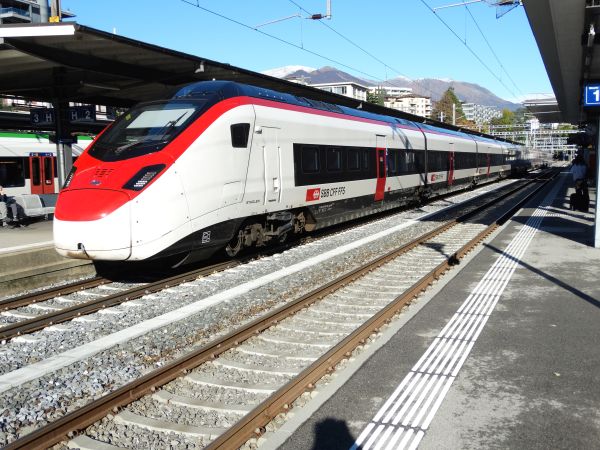
Another one of the new trains. Its manufacturer Stadler calls it Stadler SMILE, but SBB uses the name Giruno. Officially it is called RABe 501.
Picture from Lugano 4.11.2022 by Ilkka Siissalo.

This was Switzerland's no.1 train before the Girunos shown above. This is Alstom's New Pendolino, which in Italy is called ETR 610. In Switzerland
SBB calls it RABe 503 "Astoro". These trains were originally bought to Switzerland by the joint venture company Cisalpino and after Cisalpino as
a company was dissolved and the trains were divided between its owners SBB and the Italian FS Trenitalia, SBB soon decided that they like these
and they promptly ordered a new series. Now they are in traffic between Zürich and Milano and they are just about to start (or maybe have already
started) on the line from Zürich to München. Other lines deep into Germany are also planned as more new Girunos become available and can take over
the Zürich to Milano route.
Picture from Lugano 4.11.2022 by Ilkka Siissalo.

The ICN train, also known as RABDe 500 was Switzerland's first actively tilting so called bullet train. It is not prepared for use
outside Switzerland, so its use is strictly limited to Intercity and Interregio trains inside the country. It is especially used on the
Schaffhausen-Zürich-Geneve axis as well as the Zürich-Gotthard basis tunnel-Lugano-Chiasso axis.
Picture of an ICN from Zürich main station 28.9.2002 by Ilkka Siissalo.

SBB's ICN train named "Xavier Stockmar" stopping at the station of Wil.
Picture by Ilkka Siissalo 4.7.2019.

Yet another ICN train. This one is named as "Jean Rudolph von Salis".
Picture from Brugg 5.11.2022 by Ilkka Siissalo.

These new RABe 502 doubledecker InterCity trains built by Bombardier entered service at SBB gradually during 2019. In the beginning
there were really a lot of technical troubles, which spoiled the reputation of the trains badly. But since the beginning of 2020 it looks
like the situation has gradually stablilised. The RABe 502 is a remarkably long train and being a doubledecker, its passenger capacity
is incredibly large.
Picture from Gossau station 4.7.2019 by Ilkka Siissalo.

First coach of one of the new RABe 502 trains during early production phase of the new trains. The picture is from the courtyard of
Bombardier's factories in Villeneuve.
Picture from Bombardier Villeneuve 1.10.2017 by Ilkka Siissalo.

In the meantime most of the initial technical problems related to this new train type have been fixed and the trains are now in full service.
Here one RABe 502 is passing the station Wankdorf near Bern.
Picture from Wankdorf 9.5.2023 by Ilkka Siissalo.

SBB's doubledecker train of the type RABe 511 is a Stadler KISS train. The blue underparts tell us that this one works for the
Zürich area local traffic.
Picture from Brugg 5.11.2022 by Ilkka Siissalo.
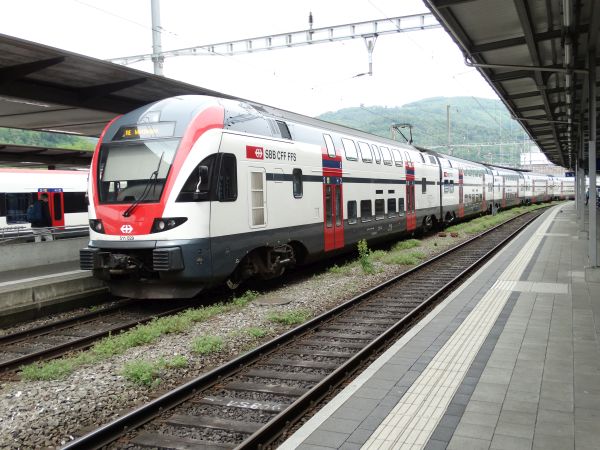
A really long doubledecker Regionalexpress train composed of two Stadler KISS RABe 511 units is arriving at Olten station.
These units have the standard grey underparts.
Picture from Olten 9.5.2023 by Ilkka Siissalo.

SBB's newest Stadler KISS trains of the new type RABe 512 are almost uniformly white except for the fronts and the doors. These are six
coaches long units intended for especially InterRegio services which stop frequently.
Picture from Frick 31.10.2024 by Ilkka Siissalo.

All white middle coaches of the new KISS units.
Picture from Frick 31.10.2024 by Ilkka Siissalo.

The main difference between these new RABe 512 KISS units and the older RABe 511 KISSes is the new "crash-proof" front design. Stadler has used this new
front part already earlier in several other railroad companies' orders such as for example BLS' "Mutz" trains.
Picture from Olten 31.10.2024 by Ilkka Siissalo.

These are second generation Bombardier TRAXX locomotives of SBB Cargo. In Germany they would be called Baureihe 185, but in Switzerland
the name is Re 484. It's a multiple electric system machine. They are most often used for picking up a cargo train from far away in Germany,
Hamburg for instance, bringing it through all of Germany, Switzerland and to Italy. Note the four pantographs on its roof.
Picture from Muttenz 5.11.2022 by Ilkka Siissalo.

Another look at one of the Re 484 TRAXX locomotives of SBB Cargo. The Swiss class Re 484 is identical with the German class Br 185.
Picture from Muttenz 5.11.2022 by Ilkka Siissalo.

Two rented Siemens locomotives working for SBB Cargo International. These machines are owned by the MRCE Dispolok. MRCE likes to call them
ES 64 F4 (= EuroSprinter 6400 kW, freight, four electric systems) but they are most commonly known by their German class Br 189.
Picture from Muttenz 5.11.2022 by Ilkka Siissalo.

Another Br189 machine of MRCE Dispolok. This one is missing all stickers referring to SBB Cargo Intenational, which had rented it.
Picture from Muttenz 5.11.2022 by Ilkka Siissalo.

This is a quite new machine. It's not owned by SBB but by the locomotive leasing company LokROLL and that's why it's not even registered in
Switzerland but it is shown as Br 193 in German register. It has been leased by SBB's daughter company SBB Cargo International. SBBCI uses
these in through traffic from Netherlands or northern Germany through Switzerland all the way to Italy. This is a Siemens Vectron with
multiple electric systems and multiple security systems to cover the countries DACHIT (Germany, Austria, Switzerland, Italy).
Picture from Muttenz 5.11.2022 by Ilkka Siissalo.

A similar Siemens Vectron like the one shown above. These red-headed Vectrons are from the very first leasing batch of SBBCI's Vectrons.
They all have names according to major stations along the route that they are frequently operating along. This one is called Freiburg.
If you have a look at the texts at its side carefully, you will notice that the regeistered owner of this machine is "D-SIEAG". That
refers to Siemens Ag in Germany. But SBBCI has rented it from LokROLL. There's minuscule LokROLL logo quite next to the driver's door.
Click on the small picture to see all these details.
Picture from Muttenz 5.11.2022 by Ilkka Siissalo.

Four similar Vectrons more.
Picture from Muttenz 5.11.2022 by Ilkka Siissalo.

Two similar rented Vectrons have here pulled a heavy container train from Italy and are here waiting for the green light to continue
their journey towards Germany.
Picture from Muttenz 13.7.2023 by Ilkka Siissalo.

Yet another new rented Siemens Vectron, but this time the renter is not SBB Cargo International, but SBB Cargo. It is in German register registered as
German Baureihe 193 and it has been accepted for use in the countries D, A and CH but it is intended for Swiss inland traffic.
Picture from Olten 20.10.2024 by Ilkka Siissalo.

A bit better view of one of the brand new rented Vectron locomotives that SBB Cargo has now received. SBB sees these rented machines as a temporary
solution for a couple of years. They have already placed a big order for new locomotives with the company Stadler, but those machines exist by now
only on paper and it will surely take some years to get them ready and accepted for use.
Picture from Olten 31.10.2024 by Ilkka Siissalo.

Re 4/4 (later Re 420) and Re 460 are probably the two most famous SBB locomotives of all times.
Picture of an Re 4/4 stopping at the station of Thalwil 21.10.2001 by Ilkka Siissalo.

The first generation Re 4/4 locomotives of Switzerland have disapperared except for some museum specimens. A couple
of them are still used by the private BLS Lötschbergbahn to drag heavy cargo trains. But the BLS
Re 4/4 I is not the same as the SBB Re 4/4 I - in fact the BLS construction is from the mid-sixties and
based on modern thyristor technology, whereas the SBB Re 4/4 I series is from the mid-fourties. SBB had
three or four of them still in the late 1990s at the Basel station to perform switcher
locomotive tasks, mainly to move passenger coaches through their wagon washing line, but also they are now long gone. This SBB Re 4/4
1. series no. 10037 seen here at the Basel SBB station was built in 1950. Here it was still in switching work in Basel. It weighs 57 tons and has a maximum
speed of 125 km/h. Its original number in the 1950s was no. 437.
A scanned old paper photo taken in May 1999 by Ilkka Siissalo.

Two first series Re 4/4 locomotives of 1950 still in switcher work at the Basel SBB station.
Photo from May 1999 by Ilkka Siissalo.
Scanned from a paper print.

Whereas still in 1999 in Basel old Re 4/4 I locomotives from the 1940s were used for shunting express train wagons, in 2010 this was already a
totally different business. First the 1940s locomotives were replaced by 1960s EMU motor wagons of the type RABe 540 because they were stronger,
but then in 2010 the same tasks were done using these brand new small electric locomotives of the type Te 922. These are made by Stadler and
in their design special care was taken that the locomotive driver would have a 360 degrees unrestricted view and his helpers would have it easy
to jump down from the locomotive and climb back up. These got the nickname "papamobil" according to the very special car that the Pope was using
during his visits to a foreign country. But these papamobils, however well designed, turned out to be too weak for the task, so old Re 4/4
locomotives have returned for these shunting tasks both at Basel and at Zürich.
Picture from Basel Hauptbahnhof (Basel SBB) 10.7.2010 by Ilkka Siissalo.

A class Ee 922 (earlier Te 922) "Papamobil" is picking up a rake of old express train wagons at Basel SBB.
Picture from Basel Hauptbahnhof (Basel SBB) 10.7.2010 by Ilkka Siissalo.

SBB's class Eem 923 shunter is a further development of the class 922 shown above. It is a true hybrid, meaning that it can operate with electric
power from an overhead catenary both at 15 kV AC 16,7 Hz as well as 25 kV AC 50 Hz. But it can also run with just its batteries or with its diesel.
It's a two-axle lightweight shunter built by Stadler. In electric mode it has a power rating of 1500 kW and a top speed of 120 km/h, so it is also
capable of fast traffic on main lines. Its diesel engine has a power rating of 290 kW, so in diesel mode it is not particularly powerful. SBB has
now 30 of these versatile machines. They were made 2010-2013.
Picture from Chavornay 12.5.2023 by Ilkka Siissalo.

The same class Eem 923 shunter as shown above, but now seen from its front.
Picture from Chavornay 12.5.2023 by Ilkka Siissalo.

Still the same class Eem 923 shunter, now seen from its other end.
Picture from Chavornay 12.5.2023 by Ilkka Siissalo.

Class Aem 940 is SBB's newest electric shunter, also capable of lighter cargo traffic on main lines, like a "big brother" of the Eem 923 shown above.
Earlier SBB used to have normally one
small Ee 4/4 or similar electric shunter on every major station, but those machines are now all 40 to 60 years old. The new thinking is that a
smaller number of a locomotive class, which is a bit bigger and more powerful would be a better way forward. SBB has now 47 of these new
shunters. They were built by Alstom and there are actually four subtypes ranging from battery-driven to dual engine electric + diesel
generator models. These can run under both 25 kV AC as well as 15 kV AC, in diesel mode or in battery operated more for example in tunnels.
Picture from Nyon 12.5.2023 by Ilkka Siissalo.

The new Aem 940 seen more from the side of its "long nose".
Picture from Nyon 12.5.2023 by Ilkka Siissalo.

Aem 940 seen more from the side of its "shorter nose".
Picture from Nyon 12.5.2023 by Ilkka Siissalo.

After the second world war traffic on the mountainous Gotthard and Simplon pass railways increased quickly and bigger and
stronger locomotives than the pre-war 1. series Re 4/4´s were quickly needed. This led to the development of a six axle
Co´Co´type locomotive, designed as a universal loco for both fast passenger trains and heavy cargo trains. The type
Ae 6/6 - Swiss pride of the fifties - is powerful, 4300 kW. Prototypes were built in 1952-53 and the type became so popular
that all together 120 units were built between 1952-66. Numbers 11401-11425 look different from the others, with a broad
chromed stripe on the sides (see the red front of a second Ae 6/6 on the left of the picture showing the chrome band).
Number 11500 shown on this picture was built in 1964 by the SLM-BBC-MFO group. It is 18,4 m long, weighs 120 tons and is
designed for speeds up to 125 km/h. The Ae 6/6 was for tens of years the most popular engine in front of fast passenger trains.
However, the stiff 6 axle Co´Co´design of the heavy Ae 6/6 causes by far more stress and damage to railroad tracks than more
modern locomotives, and since the mid-seventies the type was quickly replaced in passenger train use by smaller and more versatile
Re 4/4 3. and 4. series locomotives. Today the old Ae 6/6 is no more in regular use.
Picture from July 1999 at Delemont station by Ilkka Siissalo.

Second view of an Ae 6/6 six axle allround locomotive from the fifties. This number 11416 is from the long series built in 1955.
Every Ae 6/6 got its own name. The first ones were named after the Swiss Kantons, but as these soon ended, the next ones were
named after Kanton capital towns and cities. This one also shows the characteristic broad chrome stripes around the whole
locomotive, which were very typical of the Ae 6/6. Still as late as end of the sixties this type - then painted dark green -
was the most often seen locomotive in front of fast passenger trains and it took care of almost all traffic on the Gotthard
and Simplon mountain routes until finally replaced by the Re 6/6 in late 70s and beginning of the 80s. The original Ae 6/6 shown
here is 18,4 metres long,
weighs 120 tons but has only 4300 kW of pulling power - less than the much smaller Re 4/4, yet it stressed and broke railroad
tracks much more than the smaller Re, especially in curvaceous mountain lines. Maximum speed of the Ae 6/6 is 125 km/h.
Picture in July 1999 by Ilkka Siissalo.
Uploaded 24 June, 2002

One of the Städtelokomotiven or city locomotives, Ae 6/6 no.11499 is seen here leading a cargo train. This one used to be called "Sargans",
but in this picture it had already lost the city emblems from its sides. This individual was built in 1964 and is thus one of the newest
Ae 6/6 machines.
Picture from Lausanne 7.3.2008 by James Cannell.
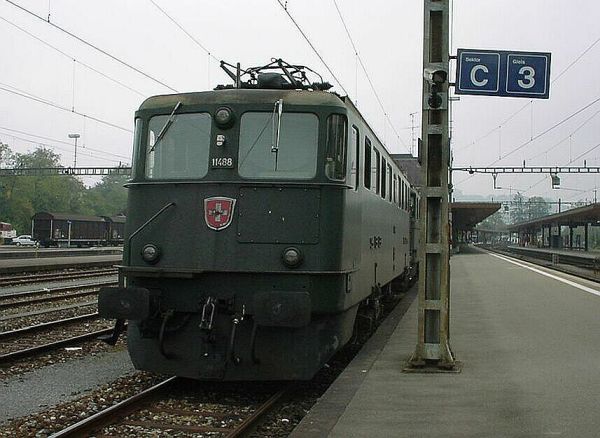
These Ae 6/6 locomotives had been sidetracked as a reserve.
These were the no. 11488 which carries the name "Mendrisio" and no. 11409 "Baselland", sitting idly on a side
track at Bülach station in September 2001. "Baselland" in the back still had the characteristic chrome stripes of the "Kantonsloks", those machines
which were named after the Swiss Kantons, "Mendrisio",
whose front shows properly on the picture, was a so called "Städtelok" or one that was named after the Kanton capital towns.
It has never had them. Both were in the original green colours of the fifties - and as
far as the rust can tell - had not received much attention since they were built in 1955.
The problem of the Ae 6/6 was the
extreme length of the stiff Co´Co´ type bogies which are 4,30 metres long. This means that in steep curves the first and the
last wheels of the bogies cause extreme stresses to the railroad tracks and grind and break them - and Switzerland has more
curves than any other railroad country: 15% of the whole SBB network is curve.
Picture from September 2001 by Ilkka Siissalo.
Uploaded 24 June, 2002

Closeup of the front of Ae 6/6 no 11409 "Baselland". If it were not so dirty and rusty it would still have been a good and fairly modern
looking locomotive. The designers of SLM and BBC did a good job in mid-fifties.
Picture in September 2001 at Bülach station by Ilkka Siissalo.

Yet another Ae 6/6, this time the Kantonslok named Ticino in red.
Picture from the Muttenz shunting yard near Basel 19.2.2003 by Ilkka Siissalo.

SBB Re 4/4 II series no. 11243 at Zürich Hbf. 19 September 1995. This one is from the long series built in 1969 and it is here
still in its original dark green livery.
Photo by Erik Hjelme.
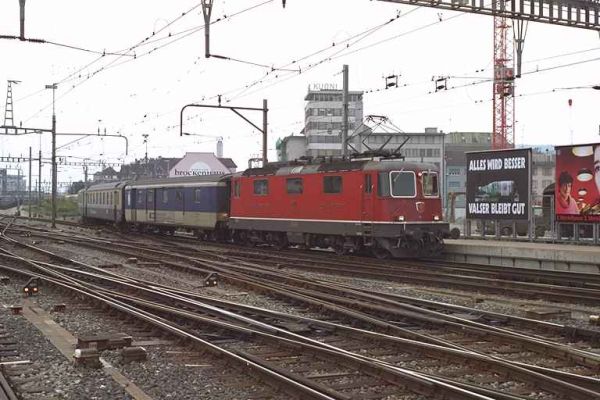
Original caption text:
An unidentified SBB Re 4/4 III series locomotive at Zürich Hbf. 19th September 1995.
Photo by Erik Hjelme.
Comment:
As the chief editor, I have to disgree. The Re 4/4 II and Re 4/4 III locomotives are notoriously difficult to distinguish from each other,
but the Re 4/4 III is longer. The easiest way to spot which is which is to have a look at the "belly of the locomotive". In the case of the
shorter Re 4/4 II (a.k.a. Re 420) there is a tank or a similar bulge in the middle of the locomotive, which is shorter, but which extends
further down than in the case of a longer Re 4/4 III (a.k.a Re 430 locomotive). If you compare this picture with the Re 4/4 III picture
shown just below it, it's clear this one is not a III but a II generation Re 4/4 machine. Regards, Ilkka, chief editor.

SBB Re 4/4 III no. 11352 of the 3. generation from the last series of 1971 - a little bit longer than Re 4/4 II, with rectangular
lights. At that time, although a more modern construction (the Re 4/4 IV or what is today Re 446 at the Südostbahn) existed
already, the SBB needed more allround locomotives and did not want to mess with the "children´s sicknesses" of the 4. generation
and wanted instead more of the old, but well known and well liked stuff. This variant was a little longer and a little more
powerful; it was designed specifically with the Gotthard mountain line in mind. The locomotive is 15,41 metres long (Re 4/4 II
is 14,8 or 14,9 m), weighs 80 tonnes, has a maximum speed of 125 km/h (as opposed to 140 of the earlier ones) and generates
4700 kW of power (like the old one), but can have a pulling force of 280 kN (as opposed to 167). Partly later replaced by the
much bigger and more powerful Re 6/6, these allrounders can still be seen all over Switzerland - like here on the Juraline in Delemont
in the north - but are still most often used on the Gotthard line bundled together with an Re 6/6 to create what is called
Re 10/10 "virtual locomotive": a commonly seen pair.
Photo from Delemont with a 1970´s aluminium mail coach in 1999 by Ilkka Siissalo

The Re 6/6 with its power of 7900 kW was for a long time the strongest locomotive in the world (and Switzerland). It has
6 axels in the somewhat rare Bo´Bo´Bo´ order. The first 4 prototypes built
in 1972 had an articulated joint for improved bending in tight curves, but
this was omitted as unnecessary in the series of 1975 (shown).
Photo of an unidentified Re 6/6 at Basel SBB station in May 1999 by Ilkka Siissalo.

This somewhat dark (sorry for that!) picture of an unidentified Re 6/6 and 2.series Re 4/4
shows the similarity and difference in size of these two famous locomotives. The Re 4/4
2.series has 4 axles, was built 1969-83 in almost 200 copies and was in the 1990s the most often seen
locomotive in front of passenger trains. The 6 axle "big brother" Re 6/6 is used mainly on
the Gotthard railroad and in front of extremely heavy cargo trains. The usual "Gotthard combination"
is one of both, forming a 10 axle really powerful combination.
Photo near Basel SBB station in May 1999 by Ilkka Siissalo.

SBB Re 6/6 no 11632 in front of a particularly heavy cargo train, stopping at the
Münchenstein station to pick up a new driver. This locomotive, built in 1975 is
one of a very successful series of 85 engines - still the most powerful locomotive
of Switzerland. On this Juraline and also on the Gotthard line, when the power of an Re6/6
is not enough, these engines are often combined together with the similar but smaller Re4/4.
Photo May 1999 by Ilkka Siissalo.

SBB Re 6/6 no 11632 shown sideways so that its remarkable length and six Bo´Bo´Bo´ evenly
dispersed axles are shown. To be able to slightly bend in curves at high speed, specially
designed bearings are used; the middle axles can move sideways.
Photo from Münchenstein, May 1999 by Ilkka Siissalo.

A closeup view of the Re 6/6 no. 11606 from the second series, built in 1975. It is still by today´s standards a
remarkably good looking engine, although the basic design is already from the 1960s.
Photo from Zürich Hauptbahnhof 9.6.2002 by Ilkka Siissalo.

Another Re 6/6 with an intermodal train, waiting with its pantographs down.
Picture from Oensingen 10.7.2010 by Ilkka Siissalo.

Side view of the same Re 6/6 as shown above.
Picture from Oensingen 10.7.2010 by Ilkka Siissalo.

Things and names have changed. Almost all the Re 4/4 and Re 6/6 locomotives of SBB have been moved to the daughter company
SBB Cargo (sbbc). And the naming notation has changed too. This used to be called Re 6/6, now it is Re 620. This
Re 620 no.021, named "Taverne-Torricella" has for a long time been used in the traffic over the Gotthard route. Here
we see it in Buchs, which is the last station in Switzerland before the Austrian border.
Picture from Buchs, St Gallen kanton, 3.11.2022 by Ilkka Siissalo.

Another view of the same Re 620 alias Re 6/6 "Taverne-Torricella".
Picture from Buchs, St Gallen kanton, 3.11.2022 by Ilkka Siissalo.
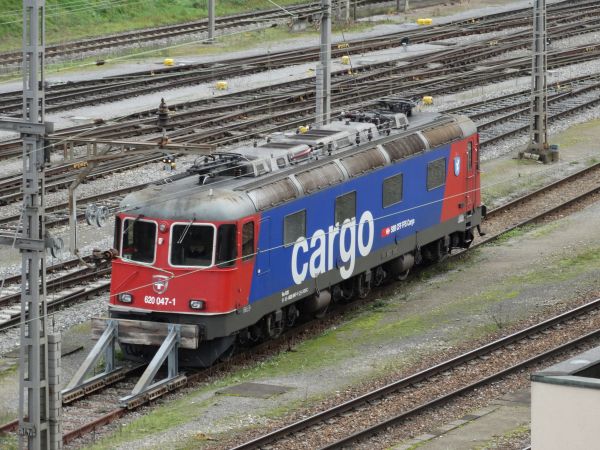
A similar Re 620 like the one above, named "Bex" and now registered as Re 620 047 of SBB Cargo.
Picture from Muttenz 5.11.2022 by Ilkka Siissalo.
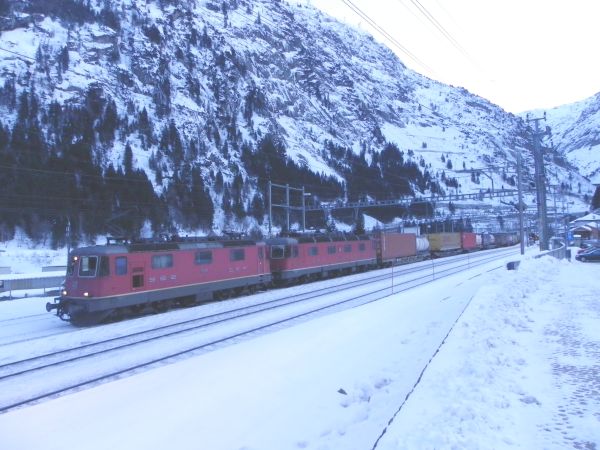
"Re 10/10" or the classic combination of one Re 4/4 II and one Re 6/6 locomotive as they used to be year after year. Now in the 2020s SBB is planning to get
rid of both these classic locomotive types. Many of the Re 6/6 (now Re 620) machines are to be sold to Sweden and the number of Re 4/4 II (now Re 420)
machines is declining also rapidly. They are already old. But this is how we used to see them at the famous Gotthard route year after year.
Picture of an Re 10/10 pair is from Erstfeld 26.1.2013 by Ilkka Siissalo.

SBB Re 460 'Lok 2000' (VI generation of Re 4/4) no. 28 at Zürich Hbf, 19th September 1995.
Photo by Erik Hjelme.

Another view of the "Lok 2000" or Re 460. Nowadays many of the Re 460s have lost their
original red painting in favor of sometimes very ugly commercial liveries acting as moving ads for this or that product.
Here is still the mighty locomotive as it is. Its maximum speed is a thrilling 230 km/h. In practise speeds of up to
200 km/h are actually used on the main lines.
Photo from Zürich Hauptbahnhof (main station) in 1999 by Ilkka Siissalo.

A quick shot from a car window: an express train on the way from Bern towards Thun and Interlaken in full speed, probably well
over 120 km/h, by the Worb SBB station. The locomotive Re 460 or "Lok 2000" with its stylish Pininfarina design is
the pride of the Swiss. These locomotives have also been sold to e.g. Norway and Finland. Germany was highly interested in
buying them as well, but could not afford the "astronomical" (as they put it) price. They developed instead their present-day Baureihe 101 and
145 locomotives based on the so called "EuroSprinter" concept. In Finland the admittedly beautiful and powerful "Lok 2000" was
not such an immediate success, as the state VR complained about overheating wheel bearings - "Something absolutely unacceptable
in this class and this priced locomotives" as they put it. SBB has in Switzerland 119 of these beautiful locomotives and they
form the basis of all high speed traffic nowadays.
Photo 14.10.2001 from Worb near Bern by Ilkka Siissalo.

Many of the modern SBB locomotives of the "Lok 2000" are painted or taped in advertisement colours; here an example of no. 42, which on 1st
November 2001 was advertising international money transfers, presumably for the tens of thousands of foreigners who live and work
in Switzerland and send money back home. Some of the advertisements look fairly tasteless; this one is actually not too bad, but
the nice looking locomotive would definitely benefit from a good wash :-) Here the locomotive was pushing an IC train from Zürich
to Geneve airport, and making a halt at Yverdon.
Photo from Yverdon station 1. Nov. 2001 by Ilkka Siissalo.

If you have a look at this picture of a dirty locomotive closely and if you happen to know about trains, it's likely to cause a "What the *beeb*"
reaction. No wonder. Yes, it is a Bombardier TRAXX locomotive. But it has a huge sticker advertising SBB Cargo International and it even carries
the locomotive name "Axen" of SBBCI. But if you have a look at it a bit closer, it's registered not to SBBCI but to BLS Cargo. It's a well known
fact that SBB and BLS are the fiercest competitors possible in Switzerland. Furhermore, a small sticker at the front declares that this machine is owned
by Akiem, which is a locomotive leasing company 100% owned by the French state railways SNCF. And yet, the loco is registered in Germany as the
German Br 186. And if you would see the opposite side of the loco, it would show no sign of SBB Cargo International, but rather advertise RAlpin
as its operator.
This machine and a couple of others of its kind used to belong to Crossrail, a private Swiss cargo train operator. But after Crossrail ended all
its cargo operations in Switzerland (It's still active in the Netherlands), these machines ended up in the "Rollende Landstrasse" service of RAlpin.
Rollende Landstrasse means "rolling highway" and its service is taking large lorries across the Alps between Germany and Italy. The main owners of
RAlpin are SBBCI and BLS Cargo and they have now rented these machines from their French owner. So although SBB and BLS are fighting with each other
like cats and dogs, they nevertheless cooperate in several areas, like this one. The machine itself is a second generation Bombardier TRAXX with
multiple electric systems and multiple train security systems that allow it to run directly from Germany via Switzerland to Italy.
Picture from Muttenz near Basel 5.11.2022 by Ilkka Siissalo.

This is the same locomotive as shown above, but now seen from a different direction.
Picture from Muttenz near Basel 5.11.2022 by Ilkka Siissalo.

On the left, still the same Ralpin Br186 TRAXX as shown above. On the right a Br193 Vectron of BLS Cargo.
Picture from Muttenz near Basel 5.11.2022 by Ilkka Siissalo.

An unidentified Ee 3/3 locomotive of the Swiss Post and Telecom PTT, switching mail wagons
at Bern Hauptbahnhof (main station). These small electric engines were built in 1991. It weighs 48 tonnes,
is only 11,20 m long and has a maximum speed of 75 km/h. Builder is the SLM/ABB group which later became
part of Adtranz and finally Bombardier group.
Photo from Bern station in June 1999 by Ilkka Siissalo.

A small electric SBB locomotive of the Te 2. series of 1967, no. 79, night time at
Liestal station, Baselland. Te´s were built by SLM, Tuchschmid AG and Maschinenfabrik
Oerlikon. The locomotive weighs 22 tons and has a maximum speed of 60 km/h.
Photo in November 1998 by Ilkka Siissalo.

The Tem 3.series locomotive no. 328 is actually not classified by SBB as a
locomotive but a "rail tractor" with both a diesel and an electric engine.
It is used in light switching work and in rail construction work as a
helper. Built by SLM, Secheron and Brown Boveri, it weights 32 tons and
has a maximum speed of 60 km/h.
Photo from Münchenstein, May 1999 by Ilkka Siissalo.

The Tem 3.series no. 328 seen from the other side. It doesn´t look like a tractor to me !
Photo from Münchenstein, May 1999 by Ilkka Siissalo.

A typical Zürich S-Bahn, here still unmodernised, an Re 450 (or 5. generation Re 4/4) with always 3 double decker coaches,
the last one of which has a cockpit very similar to the one at the locomotive end. The Re 450 is a modification
actually of the Re 460 "Lok 2000", the pride of Switzerland, but intended only for the use of pulling or pushing double
decker coaches at the Zürcher S-Bahn. For this purpose it does not have to be as fast or as powerful as the
original Lok 2000, but it still retains some of the design features. SBB has 115 of these locomotives (and 3
coach units attached to them), built 1989-97. The locomotive itself is 18,4 metres long, weighs 74 tonnes and
has a maximum speed of 130 km/h.
Photo from Zürich Hauptbahnhof (main station) in 1999 by Ilkka Siissalo.

A steering cab coach of a typical Zürich S-Bahn train Re 450.
Photo from Thalwil station 21.10.2001 by Ilkka Siissalo.

The Re 450 with its train is always a fixed 3 coach plus locomotive unit. At peak traffic two units may be coupled together.
SBB has 115 of these units, built between 1989 and 1997.
Photo from Thalwil station 21.10.2001 by Ilkka Siissalo.

After a thorough modernisation these same fixed sets of one Re 450 locomotive plus three coaches are now called "DPZplus", which
stands for Doppelstockpendelzug plus (doubledecker pendeling train plus). Note for example the new LED lights of the locomotive.
The coaches also have a proper airconditioning now.
Picture from the station of Schaffhausen 11.7.2023 by Ilkka Siissalo.

One of the modernised middle coaches of the same train as above. The yellow band denotes a first class compartment.
Picture from the station of Schaffhausen 11.7.2023 by Ilkka Siissalo.

The modernised steering cab coach at the other end of the same train as above.
Picture from the station of Schaffhausen 11.7.2023 by Ilkka Siissalo.

A typical modern Swiss regional train of the 1980´s (so called NPZ concept train),
an unidentified RBDe 560 1. series electric motor unit of the SBB on its way from Basel to Laufen on the
Juraline, stopping here at the Münchenstein station close to Basel. The first
prototypes of these trains were ordered by SBB in 1984 based on the good
experiences of similar trains of private companies such as the BLS.
Basically the same train, with some modifications, is/was in use within several
private Swiss railroads and also in Germany in the Bodensee area. Its
maximum speed is 140 km/h (some variants 125 km/h). For the Basel area
traffic SBB had six units designated RBDe 562 for the
Regio-S-Bahn-Basel-Mulhouse service, which had dual electric systems, both for the
German/Swiss 15 kV 16,7 Hz and for the French/Italian/Spanish/Hungarian
etc. 25 kV 50 Hz. These trains used to run on pendel routes via Basel, where the other
end was in Mulhouse (Müllhausen) in French Alsace (Elsass) and the other
end in Switzerland, for example in Laufen, where this train is going to.
Photo May 1999 by Ilkka Siissalo.

An unidentified SBB RBDe 560 1.series EMU (maybe RBDe 562) leading a long train from Basel to the Münchenstein
station on its way to Laufen on the Juraline.
Photo May 1999 by Ilkka Siissalo.

A typical Swiss regional EMU train of the federal SBB, here a fairly long one, with an RBDe
560 series electric motor unit pushing from the back and a matching coach with a steering cab coach
in front.
Photo 4.6.1999 at Liestal station by Ilkka Siissalo.

Closup of a suburban SBB commuter train of the type RBDe 560, this time with a yellow S-Bahn-Bern
stripe on its side.
Photo of SBB RBDe 560 on S-bahn line S3 on 15.10.2001 at Bern-Weissenbühl station, on its
way from Thun via Bern to Biel by Ilkka Siissalo.

A typical Swiss regional train, powered by an RBDe 560 unit in a nice countryside setting close to Belp, on the
Bern S-Bahn S3 line between Bern and Thun.
Photo 14.10.2001 by Ilkka Siissalo.

Wait a minute ! Something is wrong ! :-)
It looks like a very normal suburban commuter train, but it´s not normal at all. These regional trains are
always driven by the RBDe 560 series electric motor units, which look very much the same as the coaches, or, in the old days in rare cases,
by older EMUs like the RBDe 540. This train was missing its EMU motor wagon and had received an Re 4/4 universal locomotive
in its place to replace it. Federal railways SBB had a shortage of its RBDe 560 EMUs at the time due to repairs and similar
instances and this kind of odd combinations were seen sometimes in short haul S-Bahn traffic in Bern and Basel.
Photo from Wangen, near Bern 14.10.2001 by Ilkka Siissalo.

After a thorough modernisation and addition of new low-floor middle coaches, an old RBDe 560 train looks almost like new. After
modernisation SBB calls these trains now "Domino" trains.
Picture of a four-coach Domino at the station of Bellinzona 5.7.2019 by Ilkka Siissalo.

Even as the RBDe 560 trains or so called Neue Pendelzug trains, now after a through modernisation called Domino trains, have undergone that
modernisation fairly recently, still many of them have already been taken out of service and many others have been pushed to small,
unimportant sidelines far away from major cities. This is one example. Here this Domino, which has received during its modernisation a
completely new low-floor middle coach is climbing a steep hill on a small sideline route. Three coaches are hardly needed for the amount
of traffic.
Picture from Renan, kanton of Bern, 4.11.2022 by Ilkka Siissalo.

The RBe 540, or originally RBe 4/4 was first built in a 5 train prototype series in 1959 and then in series between 1963 and
1969. Altogether SBB had 76 of these trains. Originally painted dark green, they were used in fast long haul train connections,
as e.g. express trains between major cities, for example between Zürich and Bern and Geneve. They were the new, modern trains which
took care of most of the visitor traffic at the "Landesausstellung 1964", the major national exhibition of the sixties. Later
when traffic increased, these motor wagons were pushed to do S-Bahn service, mainly as the workhorses in front of heavy and
long short haul commuter S-trains. In 1991 the trains were thoroughly refurbished, repainted and got their new numbering RBe
540. Today they are decommissioned, but in the beginning of the 2000s they were still sporadically used, like here between
Bülach and Schaffhausen.
Picture in September 2001 from Bülach station by Ilkka Siissalo.
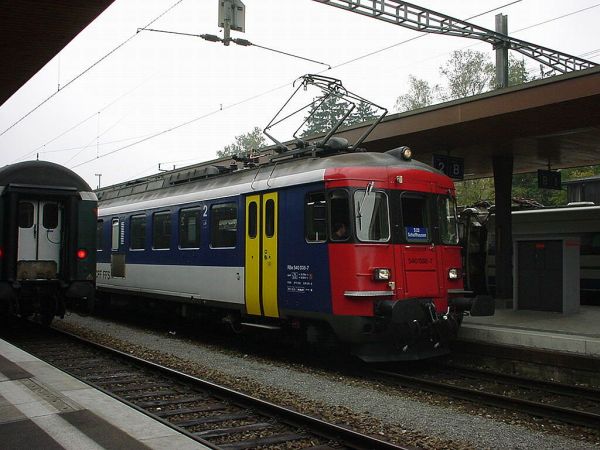
Closeup of the front of the RBe 540 no.38. This electric motor unit was built in 1963, it weighs 68 tonnes, has a maximum speed
of 125 km/h and is 23,7 metres long.
Picture in September 2001 from Bülach station by Ilkka Siissalo.

This kind of trains have been ever since the year 2000 absolutely the most common local traffic passenger trains in Switzerland.
This is a Stadler FLIRT of the type RABe 523.
Picture from Laufen 10.7.2010 by Ilkka Siissalo.

There are several slightly differing model variants of the type Stadler FLIRT in use in Switzerland. Some are just for use inside Switzerland,
some can also run in Germany or France or Italy. And some variants have more doors, others less. This one is the RABe 521 type which can run
not only in Switzerland but also in Germany. It's here seen at Basel SBB station waiting for its departure time to Lörrach in Germany.
Note the large green R-sign. That refers to the Dreilandereck area by Basel where three countries Switzerland, Germany and France all meet.
Picture from Basel SBB station 10.7.2010 by Ilkka Siissalo.

A Stadler FLIRT train of the type RABe 523 is here ready to leave the station of Olten to run a short S-Bahn service to Rothrist.
Picture from Olten 9.5.2023 by Ilkka Siissalo.

This is also a Stadler FLIRT of the type RABe 523 but as you can see, it's still not the same train as is shown above although both are classed as
RABe 523. This is the new third generation FLIRT 3.
SBB has ordered a large number of these new trains and it is planning to replace all older EMU types, including even the older FLIRTs with these new standard
models. Compare this one with the Stadler KISS doubledeckers - see below. These look very much the same like the KISSes
except that these are single-deckers. But as is obvious from this picture, these also have the newer "crash-proof" front degign.
Picture from Olten station 31.10.2024 by Ilkka Siissalo.
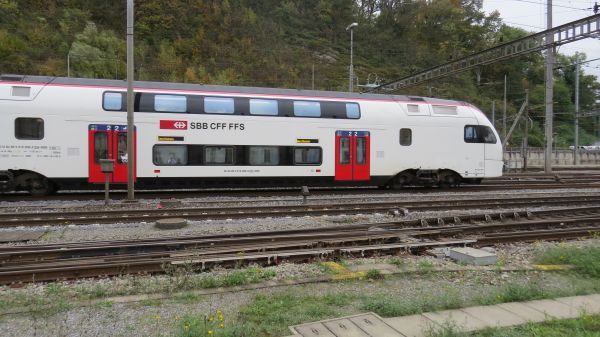
For comparison still once more one of the new Stadler KISS doubledeckers of the new type RABe 512. See more pictures of these towards the beginning of
this long page.
Picture from Olten station 31.10.2024 by Ilkka Siissalo.

This train type is the RABe 520. It resembles the FLIRT trains shown above, but unlike the FLIRTs it has a small motor wagon in its
middle. The type is a special modification of Stadler's train type GTW 2/8, built for and used only on the so called Seetalbahn route
which begins in Luzern. The Seetalbahn line runs at certain places right through tightly built old villages and even among cars
so that the trains almost touch old buildings and therefore specially designed trains which are narrower than normal trains are needed.
Note that this train individual is the RABe 520 no. 000 (!!). In Swizerland there are other train series as well where the first train
of the class is not no. 001 but 000.
Picture from Luzern 10.7.2010 by Ilkka Siissalo.

As many other national railways, now also the Swiss federal SBB has ordered modern electric motor units, so called "bullet trains".
These trains, called ICN (InterCity Neigezug) or "Weisse Pfeil" (white arrow), were first delivered by ADtranz in 2000 and
are now most often seen on the line
between Zürich and Geneve airport, but also between Zürich and Winterthur or Schaffhausen or St. Gallen and Lausanne. In contrast
to the similar trains in other countries - like the ICE in Germany or TGV in France - the ICNs are not particularly fast.
They could be, but the timetables are organised in such a way that the trains keep frequently stopping even at small and
unimportant stations like here in Oensingen. In fact they are even used in InterRegio services. Anyway, the trains are modern and
comfortable. In November 2000 SBB had 13 units of the ICNs. They are always used as two unit combinations, giving a train 14
coaches long, with 940 sitting places. The ICN is based on the Italian Pendolino by Fiat, but built completely at ADtranz in
Pratteln, close to Basel. One unit is 188,8 metres long, has 113 1. class, 12 business class and 326 2. class seats plus a
restaurant with 23 seats. Each unit has 8 motors and 28 axles in 7 coaches. Maximum speed is a modest - for a modern "bullet
train" - 200 km/h.
Photo from Önsingen station 14.10.2001 by Ilkka Siissalo.

This is one of the famous "Swiss crocodile" locomotives of the class Ce 6/8 II, the no.14270. SBB had altogether 51 of these locomotives which
had articulated bending joints. They were built 1919 to 1921. weighed 128 tons and had a maximum speed of 70 km/h. It could produce
2721 kW of power at 45 km/h. This one was for many years on display as a monument at the SBB depot in Erstfeld, but now it has been
renovated and put again in working order.
Picture from Erstfeld 19.1.2002 by Ilkka Siissalo.

The same Crocodile Ce 6/8 II no. 14270 seen from its front.
Picture from Erstfeld 19.1.2002 by Ilkka Siissalo.

SBB's class Ae 3/6 electric locomotive with a rake of light metal middle door coaches is approaching the station of Zürich-Oerlikon to then
continue towards Zürich Hbf. Picture taken with a dia slide film camera by Aarne Siissalo, father of the present chief editor of this service.
At the time when this photo was taken, the present day chief editor was six years old and stood eagerly by as daddy took the picture. This one
is the Ae 3/6 no.10604. These locomotives of the class Ae 3/6 I were built 1920 to 1929 and there were 114 of them, numbered 10601–10714. They
were scrapped between 1974–1994. It was a 92 to 96 tons weighing machine with a Buchli traction system with a power rating of 1600 kW and a top
speed of from 90 to 110 km/h. This one was one from the very first series, bult by BBC. They were intended mainly for flatland traffic especially
close to the major cities - like here.
Picture is from Zürich-Oerlikon station, taken some time during the summer of 1967 by Aarne Siissalo.

SBB's class Ae 4/7 was the one axle longer, much heavier and stronger variant of the Ae 3/6 shown above. The last Ae 4/7 locomotives were taken out
of regular use in 1995-96 but they were kept in running order for many more years as some kind of a strategic reserve. Two of these Ae 4/7 locomotives
which were stored as a reserve were for several years kept in Dreispitz in Basel. This is one of them. In the 1920s this was a remarkably strong and
fast locomotive with a top speed of 100 km/h.
Picture from Basel Dreispitz 9.10.2002 by Ilkka Siissalo.

The other one of the two Ae 4/7 locomotives which for many years were stored at Dreispitz in Basel. They happened to be parked one the other way round
with the other, so comparing these two pictures one can get a good idea how they looked like. Due to their Buchli mechanism of power transmission the
different sides of the locomotives were highly asymmetrical.
Picture from Basel Dreispitz 9.10.2002 by Ilkka Siissalo.

In the 1930s SBB created a new fast train which was thought to be the solution for routes with not too many passengers. The concept was called
Roter Pfeil, the red arrow. The red arrows were buslike electric motorwagons. 15 of them were built between 1935 and 1953. Three were two coaches
long, all the others had just one single coach with a driver's cockpit at both ends. This one is the so called Churchill-Pfeil, no. 301, later no.1021.
It was built in 1939 and was shown at the Swiss national exhibition in 1939. It got its name while Winston Churchill once used it. It has been restored
and is working now, although the original electric machinery has been replaced by something more modern now. It is owned by SBB Historic and can be
rented for special occasions.
Picture from the station of Stäfa 19.1.2023 by Vesa Kailanen.

